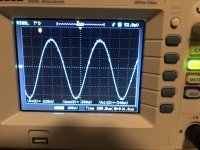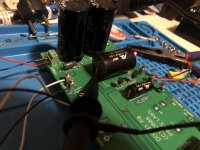Yes - even measured on the "in" pin of C201. Same result. Also measured the drain, same value. Weird.
If the source is already at supply voltage, how is it swinging positive with the signal? Can you check the signal at the source?
Hmm, I am something of a newbie when it comes to measuring current. How do I go about to measure current at the source? Do not want to damage anything.
You can measure the current indirectly by measuring the voltage drop across resistor R1 and use Ohm's law to calculate current (I = V/R).
The circuit in the PDF shows a LED and the voltage divider that goes to the gate connected to the power supply in addition to the JFETs. So, if that's what you've got, that is about 2mA (18V/15R + 18V/20R) and the rest feeds the JFETs.
The circuit in the PDF shows a LED and the voltage divider that goes to the gate connected to the power supply in addition to the JFETs. So, if that's what you've got, that is about 2mA (18V/15R + 18V/20R) and the rest feeds the JFETs.
Have you measured the actual drain-to-source voltage of each JFET? Or just voltages with respect to ground? Still wondering about your source voltage measurement of full supply voltage.
Hm, when you say "drain to source", do you literally mean that I should measure pin-to-pin on the JFet?
Sorry for being kind of lost.
Sorry for being kind of lost.
Between drain and source, measured at the pins, I get 0,21 volts? From ground to pin, about supply voltage.
There is something going on, or not going on, with the JFET. Try reflowing the solder joints, and if that doesn't do anything, it's probably time to pull them and test them out of circuit. Is it the same with both channels?
Yepp same with both sides. What if the circuit at some point in time was hooked up with reversed polarity? Would that damage the JFets?
How critical is C3 capacitor in this circuit? My schematic reading skills are still developing, and I have 1uf boutique-type caps on hand for this position, but I also have cheaper types from Digikey, which fit better.
The JFET's drain and source are generally interchangeable, but with a reversed power supply polarity, the biasing will be totally different so it is possible that excessive current can flow through them, thus causing damage.Yepp same with both sides. What if the circuit at some point in time was hooked up with reversed polarity? Would that damage the JFets?
Well, my only conclusion so far is that weird things happen once the audio signal passes the JFets - it seems that there are two plausible causes: 1.) too high bias voltage (which does not seem to be the case) or 2.) damaged JFets. I am leaning towards the latter. Only problem is that it is really difficult to get hold of LSK170, probably need to order new ones from Diy audiostore.
- Home
- Amplifiers
- Pass Labs
- B1 Buffer Preamp

